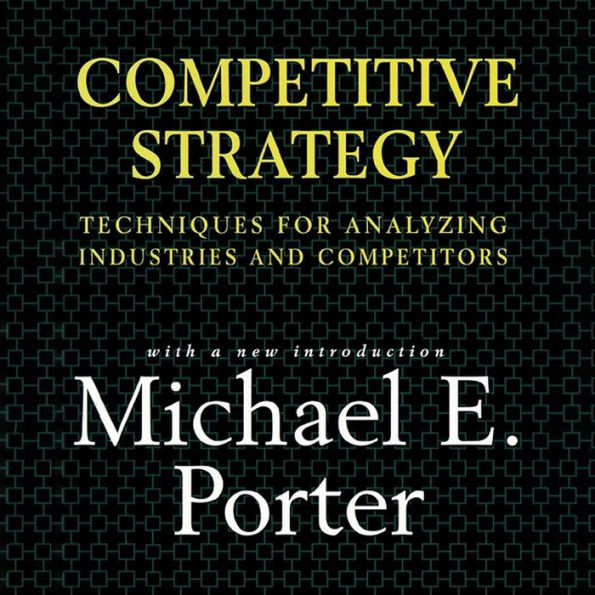Fortune Three overarching game plans that work in one industry after another explain how thousands of real-world competitors come out on top.
The New York Times American executives are grasping for a logic to global competition. Mr. Porter...has given them one.
Choice Few books warrant the too-common publisher's blurb "landmark." This one does. Highest recommendation.
Strategic Management Journal Represents a quantum leap...may well be one of the most important contributions to the discipline of strategic management.
Journal of Business Strategy Any manager who studies and uses the materials in this book should be able to devise more successful strategies.
Philip Kotler S.C. Johnson & Son, Distinguished Professor of International Marketing, Northwestern University Porter's books on competitive strategy are the seminal works in the field.
Now nearing its 60th printing in English and translated into 19 languages, Michael E. Porter's Competitive Strategy has transformed the theory, practice, and teaching of business strategy throughout the world.
Electrifying in its simplicity - like all great breakthroughs - Porter's analysis of industries captures the complexity of industry competition in five underlying forces. Porter introduces one of the most powerful competitive tools yet developed: his three generic strategies - lowest cost, differentiation, and focus - which bring structure to the task of strategic positioning. He reveals how competitive advantage can be defined in terms of relative cost and relative prices, thus linking it directly to profitability and presents a whole new perspective on how profit is created and divided. In the almost two decades since publication, Porter's framework for predicting competitor behavior has transformed the way in which companies look at their rivals and has given rise to the new discipline of competitor assessment.
More than a million managers in both large and small companies, investment analysts, consultants, students, and scholars throughout the world have internalized Porter's ideas and applied them to assess industries, understand competitors, and choose competitive positions. The ideas in the audiobook address the underlying fundamentals of competition in a way that is independent of the specifics of the ways companies go about competing.
Competitive Strategy has filled a void in management thinking. It provides an enduring foundation and grounding point on which all subsequent work can be built. By bringing a disciplined structure to the question of how firms achieve superior profitability, Porter's rich frameworks and deep insights comprise a sophisticated view of competition unsurpassed in the last quarter-century. Competitive Strategy is skillfully narrated by Scott R. Pollak.
Produced and published by Echo Point Books & Media, an independent bookseller in Brattleboro, Vermont. ©2008 Free Press (P)Now nearing its 60th printing in English and translated into 19 languages, Michael E. Porter's Competitive Strategy has transformed the theory, practice, and teaching of business strategy throughout the world.
Electrifying in its simplicity - like all great breakthroughs - Porter's analysis of industries captures the complexity of industry competition in five underlying forces. Porter introduces one of the most powerful competitive tools yet developed: his three generic strategies - lowest cost, differentiation, and focus - which bring structure to the task of strategic positioning. He reveals how competitive advantage can be defined in terms of relative cost and relative prices, thus linking it directly to profitability and presents a whole new perspective on how profit is created and divided. In the almost two decades since publication, Porter's framework for predicting competitor behavior has transformed the way in which companies look at their rivals and has given rise to the new discipline of competitor assessment.
More than a million managers in both large and small companies, investment analysts, consultants, students, and scholars throughout the world have internalized Porter's ideas and applied them to assess industries, understand competitors, and choose competitive positions. The ideas in the audiobook address the underlying fundamentals of competition in a way that is independent of the specifics of the ways companies go about competing.
Competitive Strategy has filled a void in management thinking. It provides an enduring foundation and grounding point on which all subsequent work can be built. By bringing a disciplined structure to the question of how firms achieve superior profitability, Porter's rich frameworks and deep insights comprise a sophisticated view of competition unsurpassed in the last quarter-century. Competitive Strategy is skillfully narrated by Scott R. Pollak.
Produced and published by Echo Point Books & Media, an independent bookseller in Brattleboro, Vermont. ©2008 Free Press (P)
Competitive Strategy: Techniques for Analyzing Industries and Competitors

Competitive Strategy: Techniques for Analyzing Industries and Competitors
FREE
with a B&N Audiobooks Subscription

Editorial Reviews
Product Details
| BN ID: | 2940192117101 |
|---|---|
| Publisher: | Dreamscape Media |
| Publication date: | 06/24/2024 |
| Edition description: | Unabridged |
Videos


